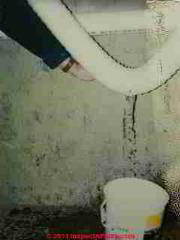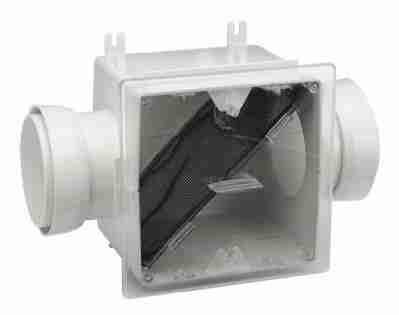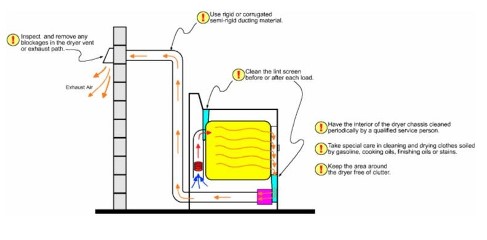 Clothes Dryer Lint Trap Safety Warnings
Clothes Dryer Lint Trap Safety Warnings
Add-on dryer lint traps may increase the risk of a building fire
- POST a QUESTION or COMMENT about clothes dryer exhaust venting, ducting installation procedures, codes, standards
Clothes dryer lint trap safety:
This article describes the fire hazards associated with add-on lint traps installed on clothes dryer exhaust vent ducts.
The lint trap that is integral with your clothes dryer should be inspected and cleaned at each dryer cycle - use. Experts advise that you should not use add-on dryer lint traps that can cause blockage in the dryer vent, overheating, and a clothes dryer fire.
This article series describes good practices for clothes dryer vent installation, lint traps, wall vents, filters, and screens. We include a list of clothes dryer fire safety hazards and other clothes dryer installation or maintenance mistakes that are either unsafe or that interfere with effective, economical dryer operation. We discuss types of dryer vent ducting and dryer vent doors or opening protection devices.
InspectAPedia tolerates no conflicts of interest. We have no relationship with advertisers, products, or services discussed at this website.
Clothes Dryer Lint Trap Fire & Safety Hazards
Warnings About Auxiliary Lint Filters for Clothes Dryers
- Clothes Dryer Lint Filters:
check and clean the laundry dryer lint filter screen at every use cycle of the dryer for optimum dryer efficiency; check and follow the manufacturer's instructions found in the dryer installation and operation manual.
Additional or add-on dryer lint filters and possible safety hazards associated with those products are discussed at CLOTHES DRYER LINT CLOG RESISTANT SCREENS - Clothes dryer wall vents:
check the exterior wall dryer vent screen monthly for lint blockage. See "Clothes Dryer Vent Exterior Wall Termination, Covers, Shields" below. - Follow the laundry dryer equipment manufacturer’s guidelines
and safety standards such as those published by the National Fire Protection association (NFPA), the American Society of Heating, Refrigeration, and Air Conditioning Engineers (ASHRAE) and the local code authorities.
Watch out: Clothes Dryer Lint Traps:
like the unit illustrated above and sold a variety of manufacturers and online stores are intended to be installed somewhere between the clothes dryer outlet and the dryer vent outlet - these are are also not recommended in some dryer installation manuals, are prohibited by some building codes, and can similarly cause overheating and fires.
Question: Secondary gas clothes dryer interior lint trap choices
My exterior vent for my gas clothes dryer clogs up with lint on a plastic screen with every load. I rarely bother to go outside and clear it unless I'm gardening in that area.
Can you suggest a better exterior vent? I've seen a 'floating' clothes dryer vent on Amazon. Under pressure from the blowing dryer the plastic lid lifts to expel air and some lint. When the dryer stops blowing, the lid drops shut to keep out insects and small animals. There is no screen. All the reviews are excellent. [1]
- HEARTLAND 21000 Dryer Vent Closure by Heartland
- Lambro Industries 289W Dryer Vent Closure by Lambro
- Fantech Dryer Booster Lint Trap - Fantech Model DBLT 4
I'm also interested in putting in a secondary lint trap, secondary to the one built into the dryer, inside where I can easily open it and clean it out between loads. Several sites say never put a secondary lint trap on a gas clothes dryer because of the danger of combustion fumes escaping inside. Below is a model I found, and when I emailed them they responded that it would be safe.
I have a rigid vent pipe for my dryer exhaust, and there is probably 5 feet of venting between the dryer and the outside portal. Thank you for your time. - Beth Clemensen
Reply:
[Click to enlarge any image]
The clothes dryer safety sketch at left (US CPSC [2]) illustrates a typical clothes dryer installation and outlines a number of fire and safety recommendations. You'll notice that the illustration does not include a secondary lint filter.
The US CPSC reported in 2000 that the lint trap was the second most common source of clothes dryer fires, and that fires in the lint trap, ducts, and dryer vents were responsible for 1/3 of all 79 dryer fires that the study investigated. Interestingly, fires at other locations such as electric motors, thermostats, and wiring may have also been related to clogged ducts and lint traps that led to overheating of those components as well. [3]
We agree that the dryer vent closures you describe offer an attractive alternative for terminating the clothes dryer vent duct line - in cases where there is no secondary lint trap to risk clogging as we make clear below.
But we also agree emphatically with advice from clothes dryer manufacturers that a secondary lint trap on a dryer vent line can lead to dangerous overheating of the system as well as increased dryer time if that device actually traps lint and restricts airflow.
We purchased a dryer vent termination product similar to the ones you describe and examined it carefully as we plan to install it on a Minnesota home where frequent checking of the dryer vent termination outside is inconvenient. The model we examined (not one of those you list) does not call itself a lint trap and it does not appear to trap any lint whatsoever. It's chief advantage is that it blows all dryer exhaust, including lint, into the outdoor air.
Other models such as the Fantech Dryer Booster Lint Trap - Fantech Model DBLT 4 and the Lint Trap by Direct Fans include a removable lint screen that can indeed clog with lint and add restriction to the dryer exhaust air flow - something that the manufacturers do not recommend.
Quoting from the US CPSC:
The U.S. Consumer Product Safety Commission estimates that in 1998, clothes dryers were associated with 15,600 fires, which resulted in 20 deaths and 370 injuries. Fires can occur when lint builds up in the dryer or in the exhaust duct. Lint can block the flow of air, cause excessive heat build-up, and result in a fire in some dryers. [2]
I would stick with the clothes dryer manufacturer's recommendations including their recommendation for metal transition ductwork, cleaning the lint screen at every dryer use cycle, and any prohibition about secondary lint filters.
Your own clothes dryer installation has the significant advantage of a very short run from the dryer to the outside of your home. If you select an outside dryer termination and animal/insect screen that does not trap lint (does not include a lint filter screen) and that opens and closes reliably operated by the dryer vent airflow, that device should be not only in compliance with the manufacturer's recommendations (as it does not include a lint trap screen), it is also (in our OPINION) safer than a vent termination insect or animal screen that becomes clogged with lint.
Follow-Up: what about unsafe blocking of combustion gases from blocked clothes dryer vents
One point, I noticed that in addressing my question about a secondary filter you didn't respond to the point about the possible dangers of blocking combustion gasses inside the house.
Reply: More on CO Carbon monoxide hazards and fire hazards from clothes dryers - carbon monoxide hazards from gas fired clothes dryer
Beth you raise a good safety point that a blocked clothes dryer vent may not only be a fire hazard but might also result in dangerous venting of combustion gases into the building. In particular, if combustion air inflow is blocked because of blocked combustion gas exhaust, the result from a gas fired appliance is likely to be the dangerous production of carbon monoxide.
We have seen that placing a smoke detector or a CO (carbon monoxide) detector too close to a clothes dryer can give off false alarms from at least some detector units, probably because of moist lint and debris becoming airborne. In our OPINION, for safety it makes sense to include a CO detector at a suitable location (not so close as to give false alarms but close enough to protect the building occupants).
It was interesting to note, when reading the clothes dryer fire research articles (cited below) that while some clothes dryers include as a safety feature devices that detect lint blockage, exhaust blockage, and excessive temperatures, those devices have been excluded from clothes dryer safety standards. [3] [4] [5] [6]
We have found references to indoor air quality hazards from un-vented clothes dryers, specifically citing "Produces excessive moisture and dust. Moisture encourages biological pollutants." It is interesting that those authors did not include carbon monoxide from un vented clothes dryers (gas fired) even though in the same article they do cite un-vented gas ranges and ovens as "A source of carbon monoxide and combustion by-products. "
It would be plausible to argue that a vented gas fired clothes dryer whose vent becomes blocked is therefore both a fire hazard and a carbon monoxide hazard. [7]
Readers needing depth in design theory and product recommendations for kitchen and bath ventilation systems should also see our BATH & KITCHEN DESIGN GUIDE and BATHROOM VENTILATION DESIGN and KITCHEN VENTILATION DESIGN or select a topic from the closely-related articles below, or see the complete ARTICLE INDEX.
Clothes Dryer Venting, Insect Pests, & Building Moisture: relationships
See CLOTHES DRYER FIRE RESEARCH
...
Continue reading at CLOTHES DRYER VENT TERMINATION & SCREENS, or select a topic from the closely-related articles below, or see the complete ARTICLE INDEX.
Or see these
Recommended Articles
- CLOTHES DRYER INSTALLATION & REPAIR - home
- CLOTHES DRYER ASBESTOS
- CLOTHES DRYER FIRE HAZARD WARNINGS
- CLOTHES DRYER FIRE RESEARCH
- CLOTHES DRYER LINT FILTER HAZARDS
- CLOTHES DRYER LINT CLOG RESISTANT SCREENS
- CLOTHES DRYER SAFETY CHECKLIST
- CLOTHES DRYER TEMPERATURES
- CLOTHES DRYER TEMPERATURE MEASUREMENTS
- CLOTHES DRYER VENTING - home
- CLOTHES DRYER VENT BOOSTER FANS
- CLOTHES DRYER VENT CLEARANCES & TERMINATION
- CLOTHES DRYER VENT CODES
- CLOTHES DRYER VENT ENERGY SAVINGS
- CLOTHES DRYER VENT INSTALLATION
- CLOTHES DRYER VENT TERMINATION & SCREENS
- DRYER EXHAUST VENT DUCT MATERIAL & SIZE
- DRYER EXHAUST VENT HOOD TYPES
- DRYER EXHAUST VENT INSTALLATION & ELBOWS
- DRYER EXHAUST VENT ROUTING OPTIONS
- DRYER EXHAUST VENT MISTAKES
- DRYER EXHAUST VENTED INTO ATTIC
- DRYER EXHAUST VENTED THROUGH ROOF
- DRYER EXAUST VENTED INTO CRAWL
- DRYER INSTALLATION & OPERATION MANUALS
Suggested citation for this web page
CLOTHES DRYER LINT FILTER HAZARDS at InspectApedia.com - online encyclopedia of building & environmental inspection, testing, diagnosis, repair, & problem prevention advice.
Or see this
INDEX to RELATED ARTICLES: ARTICLE INDEX to APPLIANCE REPAIR
Or use the SEARCH BOX found below to Ask a Question or Search InspectApedia
Ask a Question or Search InspectApedia
Questions & Answers on bathroom vent fan and fan ducting installation procedures, codes, standards.
Try the search box just below, or if you prefer, post a question or comment in the Comments box below and we will respond promptly.
Search the InspectApedia website
Note: appearance of your Comment below may be delayed: if your comment contains an image, photograph, web link, or text that looks to the software as if it might be a web link, your posting will appear after it has been approved by a moderator. Apologies for the delay.
Only one image can be added per comment but you can post as many comments, and therefore images, as you like.
You will not receive a notification when a response to your question has been posted.
Please bookmark this page to make it easy for you to check back for our response.
Our Comment Box is provided by Countable Web Productions countable.ca
Citations & References
In addition to any citations in the article above, a full list is available on request.
- John Cranor [Website: /www.house-whisperer.com ] , ASHI certified home inspector (house-whisperer.com) in Richmond, VA, can be reached by email to: johncranor@verizon.net or by telephone at 804-873-8534. Technical review, email, 1/2012
- [7] "Healthy Indoor Air for America's Homes, Indoor Air Hazards Every Homeowner Should Know About - room by room assessment", U.S. Government Publications, web search, 11/30/2011, original source: http://publications.usa.gov/epublications/indoorair-hazards/assessment.htm More about this information source, quoting the US Government website:
... Federal Citizen Information Center (FCIC) has been a trusted one-stop source for answers to questions about consumer problems and government services. FCIC, part of the General Services Administration's Office of Citizen Services and Innovative Technologies, has traditionally provided publications to consumers via the publications distribution center in Pueblo, Colorado. The Pueblo.GSA.gov website was where consumers could go to find information and order publications on a variety of topics from the federal government.
Publications.USA.gov replaces the former Pueblo.GSA.gov. - [8] "The Facts About Clothes Dryer Exhaust Systems", John Cranor, the ASHI Reporter, April 2005,American Society of Home Inspectors,® Inc., 932 Lee Street, Suite 101, Des Plaines, Illinois, 60016, Tel: 847-759-2820, website: ashi.org, original source: ashireporter.org/articles/articles.aspx?id=161
- [9] Tjernlund Residential Capacity Dryer Duct Booster®, "Dryer Duct Booster Fan Model LB1, Installation Instructions" [PDF], Tjernlund Products, 1601 9th Street
White Bear Lake, MN 55110-6794 , (800) 255-4208, web search 01/06/2012, original source: tjernlund.com/dryer_booster.htm Quoting:
The Dryer Duct Booster®, Model LB1, has been specifically designed to boost residential capacity clothes dryer duct exhaust velocities where dryer duct runs exceed 25 equivalent feet. Proper exhaust velocities will reduce drying times, save energy and prevent lint buildup in the dryer duct. The LB1 is controlled by an electronic Pressure Response Control (PRC) for automatic operation. The LB1 utilizes galvanized steel construction, a reverse inclined, particulate handling impeller that is guaranteed not to clog with lint and an externally mounted PSC motor for trouble-free operation. - "About the House - Bathroom Vents", Henri deMarne, New England Builder, November 1985
- "Bathroom Vent Fan Beats Open Window", James Dulley, Poughkeepsie Journal, 11/4/1987 p. 12D.
- Mark Cramer Inspection Services Mark Cramer, Tampa Florida, Mr. Cramer is a past president of ASHI, the American Society of Home Inspectors and is a Florida home inspector and home inspection educator. Mr. Cramer serves on the ASHI Home Inspection Standards. Contact Mark Cramer at: 727-595-4211 mark@BestTampaInspector.com
- Our recommended books about building & mechanical systems design, inspection, problem diagnosis, and repair, and about indoor environment and IAQ testing, diagnosis, and cleanup are at the InspectAPedia Bookstore. Also see our Book Reviews - InspectAPedia.
- In addition to citations & references found in this article, see the research citations given at the end of the related articles found at our suggested
CONTINUE READING or RECOMMENDED ARTICLES.
- Carson, Dunlop & Associates Ltd., 120 Carlton Street Suite 407, Toronto ON M5A 4K2. Tel: (416) 964-9415 1-800-268-7070 Email: info@carsondunlop.com. Alan Carson is a past president of ASHI, the American Society of Home Inspectors.
Thanks to Alan Carson and Bob Dunlop, for permission for InspectAPedia to use text excerpts from The HOME REFERENCE BOOK - the Encyclopedia of Homes and to use illustrations from The ILLUSTRATED HOME .
Carson Dunlop Associates provides extensive home inspection education and report writing material. In gratitude we provide links to tsome Carson Dunlop Associates products and services.



